Slope 51°20'25 Constructed 2511 BC | Type True Pyramid Height 61 m | |
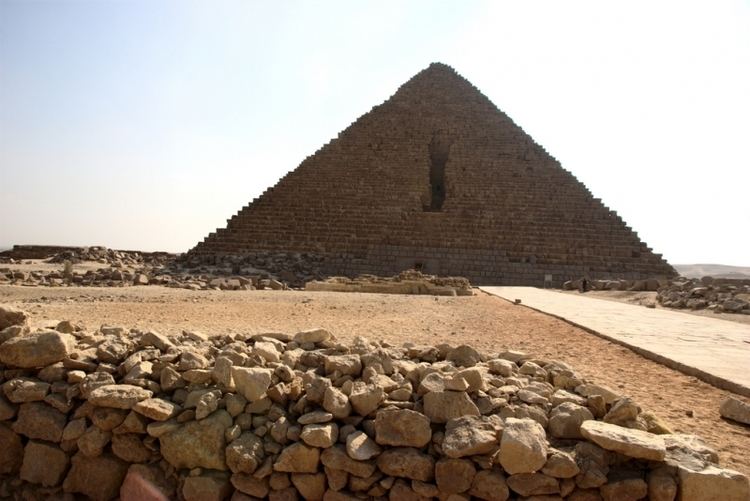 | ||
Base 102.2 by 104.6 metres (335 ft × 343 ft) Volume 235,183 cubic metres (8,305,409 cu ft) Architectural style Ancient Egyptian architecture Similar | ||
Pyramid of menkaure giza egypt
The Pyramid of Menkaure, located on the Giza Plateau in the southwestern outskirts of Cairo, Egypt, is the smallest of the three main Pyramids of Giza. It is thought to have been built to serve as the tomb of the fourth dynasty Egyptian Pharaoh Menkaure.
Contents
- Pyramid of menkaure giza egypt
- Inside pyramid of menkaure
- Size and construction
- Temple complex
- Age and location
- Coffin and sarcophagus
- Attempted demolition
- References
Inside pyramid of menkaure
Size and construction

Menkaure's pyramid had an original height of 65.5 metres (215 feet) and was the smallest of the three major pyramids at the Giza Necropolis. It now stands at 61 m (204 ft) tall with a base of 108.5 m. Its angle of incline is approximately 51°20′25″. It was constructed of limestone and granite. The first sixteen courses of the exterior were made of red granite. The upper portion was cased in the normal manner with Tura limestone. Part of the granite was left in the rough. Incomplete projects such as this pyramid help archaeologists understand the methods used to build pyramids and temples. South of the pyramid of Menkaure are three satellite pyramids that are each accompanied with a temple and have a substructure. The southernmost is the largest and a true pyramid. It's casing is partly of granite, like the main pyramid, and is believed to have been completed due to the limestone pyramidion found close by. Neither of the other two progressed beyond the construction of the inner core.
Temple complex
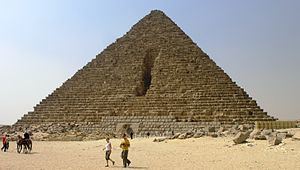
In the mortuary temple the foundations and the inner core were made of limestone. The floors were begun with granite and granite facings were added to some of the walls. The foundations of the valley temple were made of stone. However both temples were finished with crude bricks. Reisner estimated that some of the blocks of local stone in the walls of the mortuary temple weighed as much as 220 tons, while the heaviest granite ashlars imported from Aswan weighed more than 30 tons. It was not unusual for a son or successor to complete a temple when a Pharaoh died, so it is not unreasonable to assume that Shepseskaf finished the temples with crude brick. There was an inscription in the mortuary temple that said he "made it (the temple) as his monument for his father, the king of upper and lower Egypt." During excavations of the temples Reisner found a large number of statues mostly of Menkaure alone and as a member of a group. These were all carved in the naturalistic style of the old kingdom with a high degree of detail evident.
Age and location
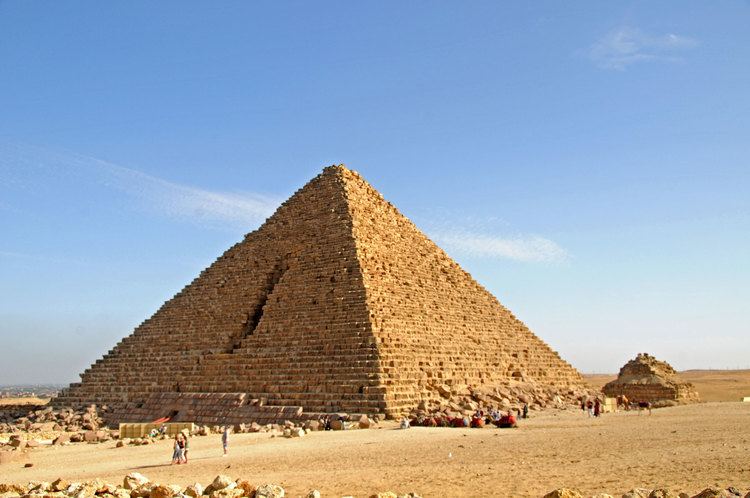
The pyramid's date of construction is unknown, because Menkaure's reign has not been accurately defined, but it was probably completed in the 26th century BC. It lies a few hundred meters southwest of its larger neighbors, the Pyramid of Khafre and the Great Pyramid of Khufu in the Giza necropolis.
Coffin and sarcophagus
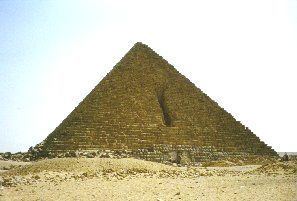
Richard William Howard Vyse, who first visited Egypt in 1835, discovered in the upper antechamber the remains of a wooden anthropoid coffin inscribed with Menkaure's name and containing human bones. This is now considered to be a substitute coffin from the Saite period, and radiocarbon dating on the bones determined them to be less than 2,000 years old, suggesting either an all-too-common bungled handling of remains from another site, or access to the pyramid during Roman times. Deeper into the pyramid, Vyse came upon a beautiful basalt sarcophagus, rich in detail with a bold projecting corniche . Unfortunately, this sarcophagus now lies at the bottom of the Mediterranean Sea, having sunk on October 13, 1838, with the ship Beatrice, as she made her way between Malta and Cartagena, on the way to Great Britain. It was one of only a handful of Old Kingdom sarcophagi to survive into the modern period. The anthropoid coffin, however, was successfully transported on a separate ship and may be seen today at the British Museum.
Attempted demolition
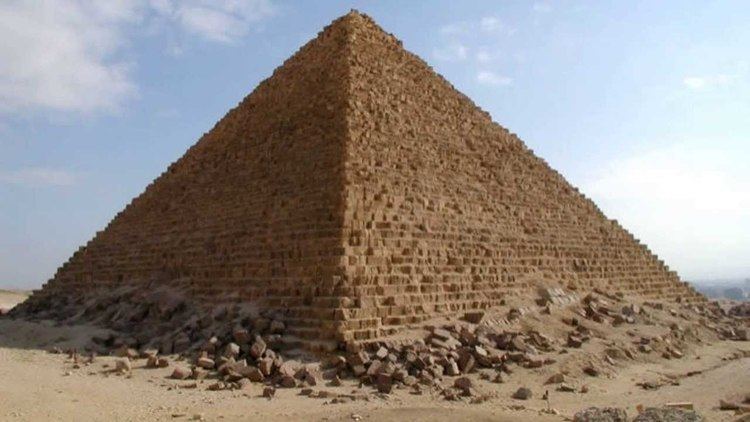
At the end of the twelfth century al-Malek al-Aziz Othman ben Yusuf, Saladin's son and heir, attempted to demolish the pyramids, starting with Menkaure's. The workmen whom Al-Aziz had recruited to demolish the pyramid found it almost as expensive to destroy as to build. They stayed at their job for eight months. They were not able to remove more than one or two stones each day at a cost of tiring themselves out utterly. Some used wedges and levers to move the stones, while others used ropes to pull them down. When a stone fell, it would bury itself in the sand, requiring extraordinary efforts to free it. Wedges were used to split the stones into several pieces, and a cart was used to carry it to the foot of the escarpment, where it was left. Far from accomplishing what they intended to do, they merely spoiled the pyramid by leaving a large vertical gash in its north face.
